How to Play
Objective
The objective of the game is to be the first player to acquire and add all six keys to happiness to their rainbow of happiness.
Setup
Each player locks their playing piece into one of the spaces on the wheel in the center of the game board. Each player takes the corresponding colored rainbow and happiness button. The players assemble their rainbows by adding a stand to their rainbow piece. The key pieces are sorted by type and placed on the corresponding space on the game board. All of the cards and other cardboard pieces are shuffled and placed in their corresponding places on the game board.
A Player’s Turn
A player’s turn can start in two different ways.
To begin the game and after completing a track, a player’s pawn may be attached to the spinner in the middle of the board. If the pawn has not been spun yet, the player spins the wheel. The player can then choose to remove their pawn from the wheel and place it onto the track where the wheel stopped. If the player doesn’t like the track they landed on, they can keep their pawn on the wheel.
If the pawn has already been spun at least once, the player can remove their pawn from the wheel at the beginning of their turn and proceed to move along the corresponding track on the current turn.
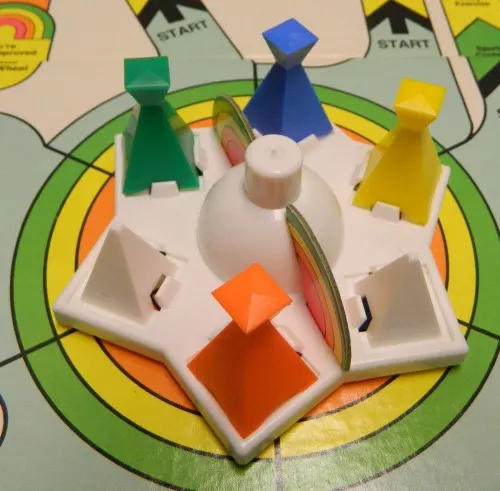
Here is the main spinner in the game of Happiness. Each player can either go down the path that their pawn points towards or they can spend their turn to spin the wheel again.
If a player’s pawn is already on a track, the player uses the form of movement for their current track.
- Friendship: Press down the hand and move the number of spaces indicated by the space that the ball lands in.
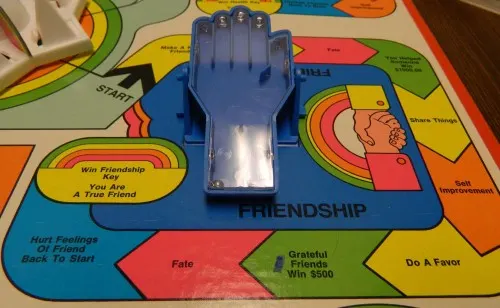
Here is the friendship track. Press down on the tips of the fingers in order to get the ball to fall into one the fingers. The player moves the number of spaces corresponding the the finger the ball lands in.
- Love: Spin the heart spinner and move the corresponding number of spaces.
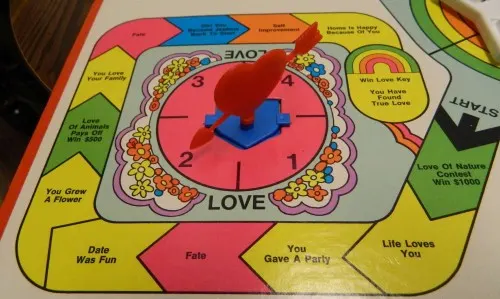
This is the love track. The heart spinner was spun and it landed on the two space. The player will get to move their pawn forward two spaces.
- Self-Improvement: Take the top bookshelf card and move the corresponding number of spaces.
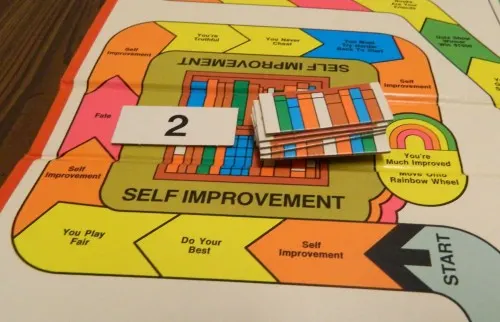
Here is the self improvement track. The player drew the top card which was a two. The player will move forward two spaces.
- Knowledge: Spin the knowledge spinner and move the number of spaces indicated.
- Faith: Spin the faith spinner and move the number of spaces indicated.
- Health: Take the top bicycle wheel card and move the corresponding number of spaces.
Unique Spaces
When moving around the various tracks, players will land of different colored spaces. Each type of space does different things for the player.
- Yellow Spaces: Read the “cute” little saying and your turn ends immediately.
- Green Spaces: The player receives the corresponding amount of money that is printed on the space.
- Red Spaces: Unless the space has a happiness button on it, the player is forced to draw a fate card which is usually not a good thing.
- Blue Spaces: The player is forced to go back to the beginning of the track that they are currently on.
- Orange Spaces: The player draws the top self improvement card and keeps it or uses it to get rid of one of the hang-up cards currently in front of the player.
- The Final Space: By reaching the final space on a track (doesn’t have to be by exact count) the player earns the corresponding key to happiness cardboard piece. The player places their pawn on the spinner in the center of the board on the space corresponding to the track they just completed. If this spot is occupied by another player, the finishing player can put their pawn on any space in the center wheel.
Key Cards
Key cards are acquired in one of two ways. A player takes the corresponding key card as soon as the reach the end of one of the tracks. The self improvement track doesn’t have a corresponding key so no key is taken when the end of the track is reached.
Players earn the money key card by acquiring $2,500. The player cashes in the money and receives the money key card.
Each player may only take one of each type of key card.
Placing Key Cards On Your Happiness Rainbow and Holdups
When a key card is acquired it can be immediately placed on a player’s happiness rainbow if the player currently has no hang-up card in front of them that correspond to the same category. For example if a player just acquired a love key card but has a hang-up love card, the player is unable to add the card to their rainbow until they get rid of the hang-up card. This key card is kept by the player until it is able to be added to the rainbow.
A player will receive hang-up cards throughout the game by landing on fate spaces. These hang-up cards can only be removed when the player acquires a self-improvement card of the same type. To remove a hang-up card, the corresponding self-improvement card is discarded. Players can acquire self-improvement cards and hold them until they are needed later in the game. If a self-improvement card is already held by a player that matches a hang-up card that is drawn, both are discarded immediately.
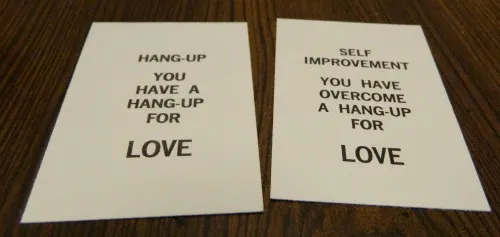
The card on the left is a hang-up card for love. In order to get rid of this card, the player will need to draw a self improvement card for love which is on the right.
Once a key card has been added to a player’s happiness rainbow, all self improvement cards related to that category are discarded by the player. Any holdup or self-improvement cards drawn of that type in future turns are immediately discarded. Money is not collected after a player has added the money key card to their rainbow.
Happiness Buttons
Each player has a happiness button that they can use to help out the other players. During each turn the player can choose to place their happiness button on any unoccupied fate space. If another player lands on a space which has a happiness button on it, they get to avoid drawing a fate card. For helping out another player, the player who played the happiness button that was landed on gets to take the top self-improvement card. If a player lands on their own happiness button, they still have to draw the fate card.
End of Game
When one player is able to place their last key card on their rainbow of happiness, the game ends immediately. This player wins the game.
Review
In the 1970’s and 1980’s it seems like the major board game manufacturers tried to break out of their comfort zones and develop some more unique ideas for board games. While a lot of these games weren’t particularly good and didn’t sell well, I give them credit for trying something new.
When I ran in the Happiness game at a thrift store, it immediately caught my eye. Just looking the the box I could tell that this was one of those weird/wacky board games from the past that obviously never caught on. Even though I knew the game probably wouldn’t be very good, I decided to pick it up since it looked like it would be a unique experience. After playing the game my first impression was right on both accounts.
A+ For Effort
One thing that you have to give the Happiness game credit for is that the creators tried their hardest to try and make an original spin and move game. This genre of games generally lack originality and new ideas. In most of these types of games you spin and move around the board collecting money or cards as you get closer to the winning conditions. Since there are few decisions to be made, these games have little to no strategy which usually makes them quite boring.
The Happiness game was not content with just being another spin and move game. The creators of the game tried to come up with every type of movement mechanic that they could think of (except for using dice for some reason). Some of the movement mechanics include having your pawn spun in a wheel, using a spinner shaped like a heart, navigating a little ball around a hand, and drawing cards.
The game deserves credit for trying some new things. Unfortunately all that effort was wasted since none of the mechanics really work. Outside of the pawn spinner, which I liked, the mechanics don’t really add anything new to the spin and move genre. The different types of spinners get boring quickly since there really is no difference between them. The ball in the hand device is interesting but it is easy to manipulate. The cards are boring to draw.
The problem with the Happiness game is that it begins to feel like a big scavenger hunt/fetch quest. Pretty much all you do in the game is move around the board gathering keys while trying to avoid hang-ups. This makes the game feel like every other spin and move game. You have next to no decisions to make so the outcome will be determined by who spins the best. This unfortunately makes the Happiness game a pretty boring game overall.
Fate Spaces and Hang-Ups
In addition to the multitude of spinners, the Happiness game adds in fate spaces and hang-ups. Hang-up cards essentially work as roadblocks that a player has to overcome before they are able to win the game. Whenever you land on a fate space you will likely be forced to take a hang-up card which means that you will need to get the corresponding self-improvement card in order to get rid of it.
These hang-up cards had some potential but they are mostly a total waste of time. As a matter of fact I only think one player in the entire game ever got stuck with hang-up card. The only reason this one player got a hang-up card was because they got it on one of their first turns before they had any self-improvement cards. All of the other players already had a self-improvement card on hand which offset any hang-up cards that were drawn. My problem with the fate spaces and the hang-up cards is that they have no impact on the game.
First the game gives players too many opportunities to get self-improvement cards. At one point in the game I think I had at least five different self-improvement card placed out in front of me. If I ever had to draw any hang-up cards, I likely would have been protected from them.
As the game progresses the hang-up cards end up weeding themselves out. Whenever you add a key to your rainbow, you can start ignoring any hang-up cards that correspond to the category that you just placed on your rainbow. As the game progresses you will get more keys on your rainbow which means that your chances of drawing a hang-up card that you actually have to keep, decreases exponentially.
The happiness buttons are the biggest culprit for players avoiding hang-up cards. Due to the happiness buttons, whenever anyone actually ended up landing on a fate space, they were protected by one of the other players. I give the game credit for rewarding players that help out other players but the reward tended to get people to help one another too much. Towards the end of the game players started to remove their buttons from the board but at that point it seemed too late. Players had already acquired too many keys and self-improvement cards that there was no way that the hang-up cards would make an impact on the game. While the bonus self-improvement card does seem enticing at first, I think you are better off not playing the button onto the game board at all. You would get less self-improvement cards but you get enough already that the cards you get for helping the other players don’t really do anything anyway. I think it would have been better to force the other players to draw fate cards and likely have to deal with hang-up cards.
The Cheesiest Game I Have Ever Played
Just looking at the name of the game, it should be pretty obvious that the Happiness game was not going to be a very serious game. I was quite surprised by how cheesy it ended up being though.
If you were going to imagine the a game that perfectly encapsulated the 1970’s the Happiness game would be that game. The game feels like the perfect board game for hippies and other peace lovers. I wasn’t alive in the 1970’s but the game looks exactly like what I would expect from a game from that era.
I have to say that the Happiness game is quite possibly the cheesiest game I have ever played. Here are just a couple example of some of the sayings printed on the game board:
- “Loyalty Is Your Bag”
- “Life Loves You”
- “Home Is Happy Because Of You”
- “Books Are Your Friends”
- “Phoniness Is Out”
This cheesiness is kind of good and bad at the same time. I actually kind of liked the cheesiness since it kind of brings you back to the 1970’s, a decade I never experienced. I had some fun exploring how cheesy the game actually could become. Around every turn I found more cheesiness and it kind of got charming after a while. At times it was funny how cheesy the game was. Clearly it doesn’t fix the many problems with the game, but it does make the game an interesting experience. If you hate cheesy/feel good stuff, I think you are going to hate the Happiness game.
Did I Just Break the Spinner
With so many strange mechanics in the game, the discussion of the game’s components becomes pretty interesting.
For the most part the components are what you would expect from a Milton Bradley game from the 1970’s. Most of the spinners spin pretty well. I would highly recommend snapping your playing pieces into position before spinning the center wheel though because as my group experienced the piece will fly across the board if you don’t. The hand piece actually works pretty well despite being easy to manipulate. Otherwise the artwork and design of the cards are nothing special but are typical of their time.
I have to talk about the terrible heart spinner though. The heart spinner, while nice for the theme, is quite possibly the worst spinner I have ever seen in a board game. The heart spinner is really hard to spin. When spun it barely spins. Not to mention that it flew off the board at least once when someone tried spinning it. Due to the spinner, you are going to hate your time on the love track.
Final Verdict
The Happiness game is a very unique experience. The Happiness game has to be one of the cheesiest games I have ever played. It is pure 1970’s hippie/love culture at its’ finest. The game tries to do a lot of new things for the spin and move genre but unfortunately none of the things attempted really end up working. This leads to the Happiness game being a boring game. If you hate spin and move games you will hate the Happiness game.
There is something to say about the uniqueness of the game though. You are unlikely to ever play another game like it. While I didn’t particularly enjoy playing the game, I don’t regret playing it. It was a unique experience. I wouldn’t play the game ever again though. Due to being an older game that appears to be somewhat rare, I really can’t recommend buying the game. If you ever find the game at a garage sale or a thrift store though for cheap and want to experience a unique game I think it could be worth a quick look.

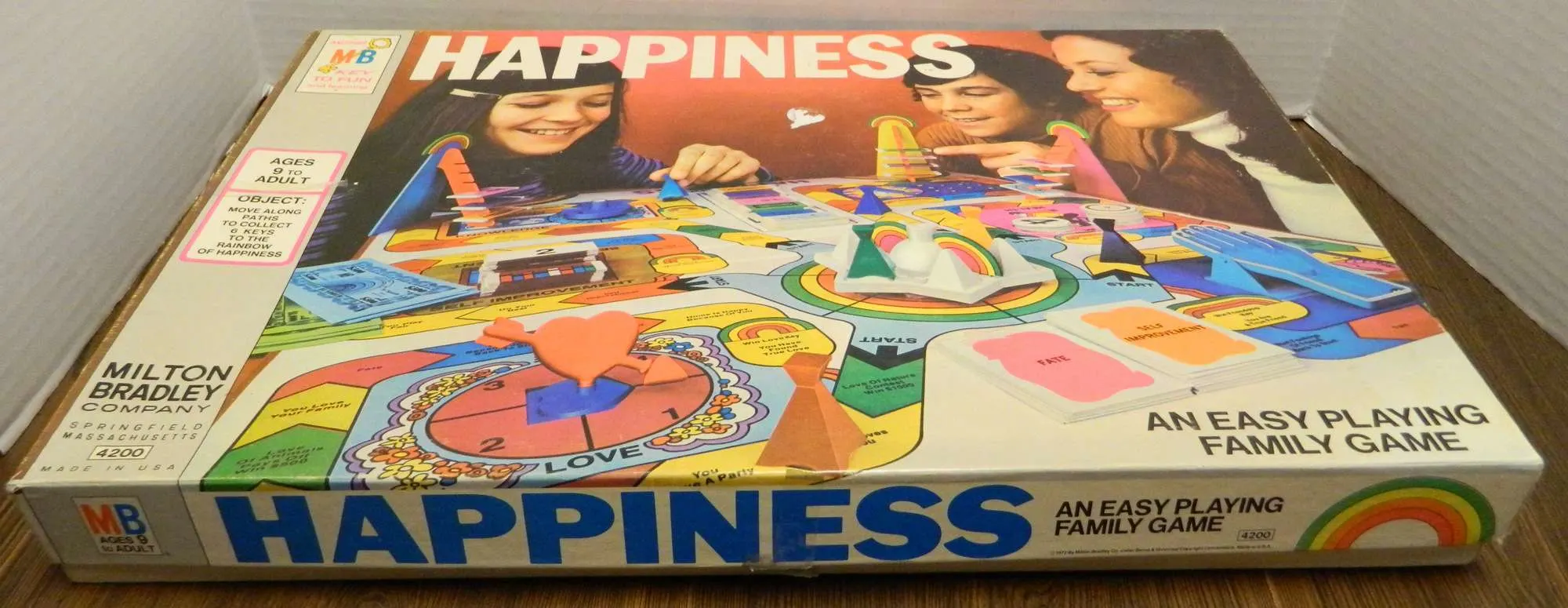
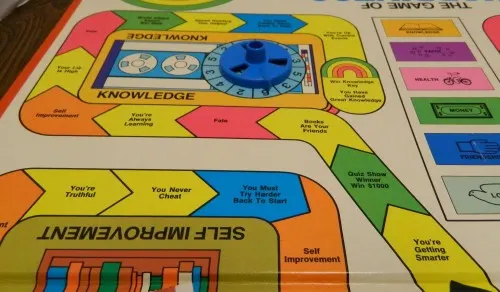
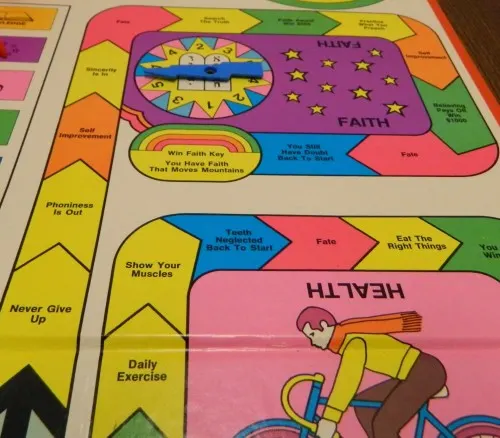
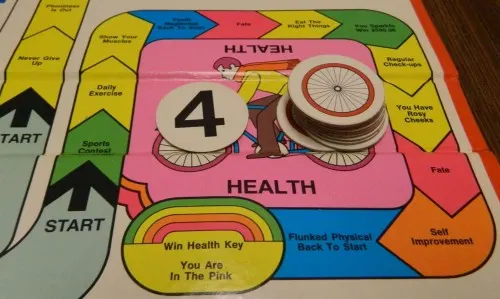
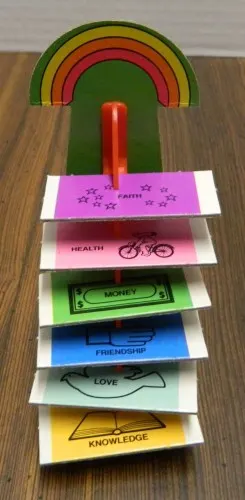
pinkfreud62
Saturday 18th of February 2017
I had this game when I was a pre-teen in the 70's and my girlfriend and I had alot of fun. As far as it lacking originality, keep in mind CHILDREN were playing and pretty much everything for a child is a new experience during their era. I cannot see how an adult critic in this day and age can fairly review a board game that was conceived in earlier decades when things were new, simple and adequate fun for a child (especially a girl) in days before video games.
Eric Mortensen
Saturday 18th of February 2017
Hello.
Thank you for the comment. I would like to talk about my thoughts on the Happiness Game. To begin with I would like to point out that the Happiness game was created about 15 years before I was born. Therefore when I review a board game that was made before I was born there is no way I can judge it based on its' time period.
As far as judging the game I am judging it based on today because my reviews are meant for people that might be interested in board games that they have never heard of before or know very little about. I think it is fair to judge games in today's terms because there are many options for board games out there (I have reviewed over 400 board games on this site alone). I want my reviews to be helpful for people that want to learn about a game before they decide whether to pick up it. Therefore I think it is fair to compare the game to games made today since if I think a newer or older game is better than another game I am going to express my opinion. While I usually like newer games more than older games, that is due to these newer games taking what worked from older games and improving on them. With that in mind there are some older games that I have enjoyed.
When you get down to it, my review is just my opinion. There are plenty of people that probably disagree with my opinion. If you played the game when you were younger you would have fond memories of the game. There are games that I played when I was a kid that children today would think are terrible. Without those fond memories though I have to judge the game based on my opinion on how the game stands up today.
Eric
Mel
Monday 22nd of August 2016
Where can I find a parts list to this game? Thanks.
Eric Mortensen
Tuesday 23rd of August 2016
Hello.
On the right sidebar of this page I have a breakdown of the components that are supposed to come with the game. If you want a more specific list of the cards I unfortunately don't know where you could find one.
Stephen Witzig
Sunday 2nd of August 2015
I picked up this game exactly the way that you did. I was traveling, and it caught my eye at a thrift store, and I only paid 50 cents! It had all of the pieces (amazingly) except for the instructions. After scouring the web for instructions, I found a set. However, it didn't say what to do with the "Hang up" cards (and there was no spot on the board for them). So, we played the game without them at first, thinking they would come into play as we played. We ran into the same thing you did - Self-improvement cards were plenty, and quickly cancelled out any fate card drawn that gave you a hang-up. Something was missing. So, I went back to the searching the internet for more instructions (which is how I found you review - which wasn't around last week was I searched), and I found another page with a review that said to start the game, every player is given 6 hang-up cards which are dealt face up. Well, that made sense. These are initial road blocks that you have to cancel. Also, the number made sense, as there are 36 hang-up cards, and 6 potential players (6x6=36). Anyway, I don't think this really would change the way you gave your review, but from one board game geek to another, I thought I would share what I found. Cheers, - Stephen
Eric Mortensen
Sunday 2nd of August 2015
Thanks for the additional information. My copy of the game didn't come with the instructions either so I played the game based on what I found on other websites.